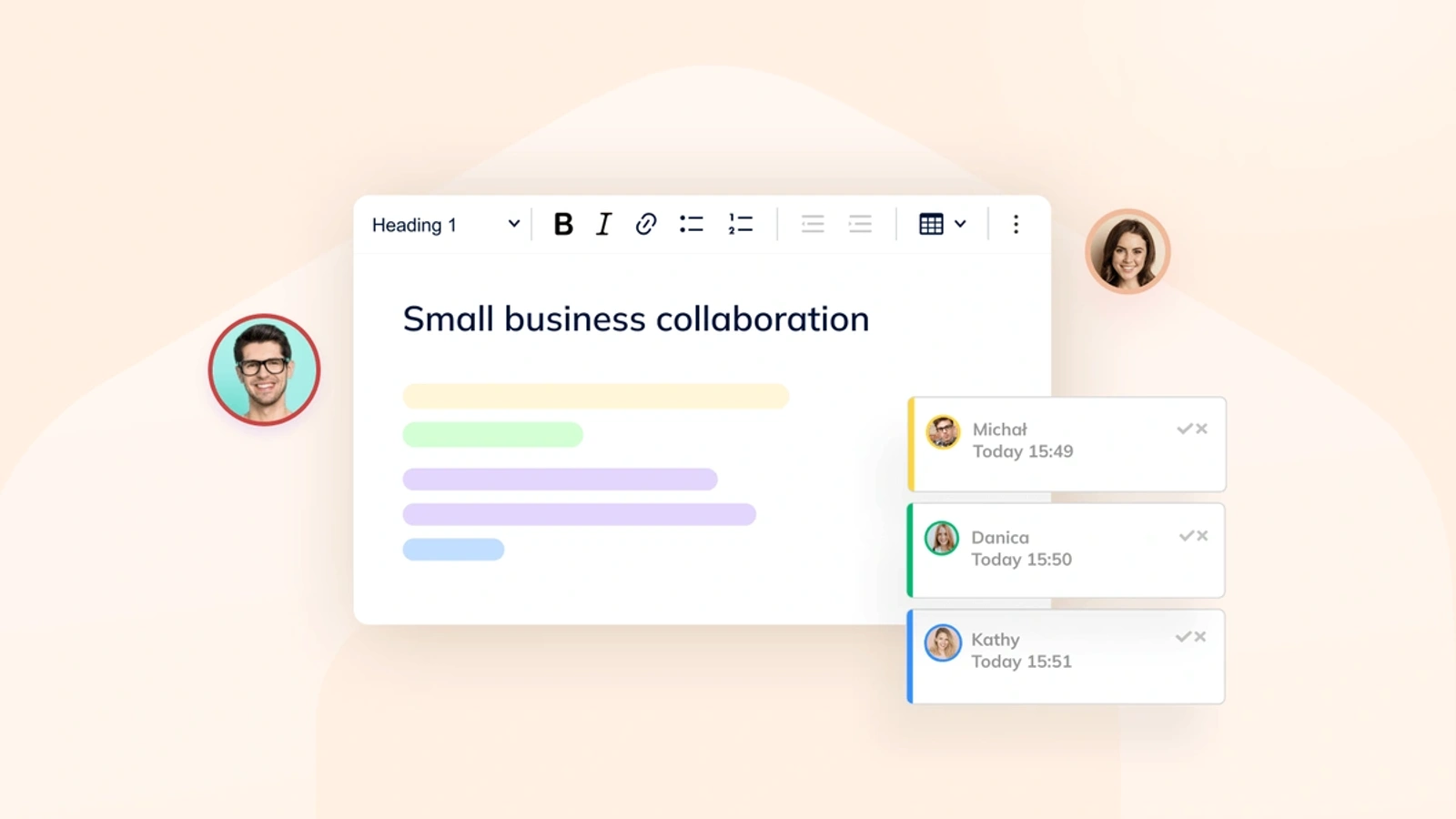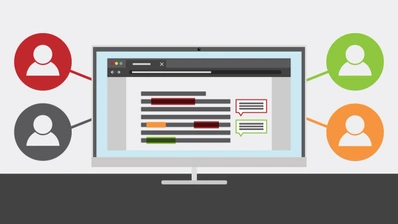Overcoming common small business collaboration challenges

Small-to-medium enterprises (SMEs) face a range of challenges that their larger counterparts don’t experience. When they need to boost productivity, small businesses can’t simply bring on new staff the way a larger corporation can. Instead, improving SME productivity often means finding ways to do more with less – starting with improvements in their small business collaboration.
Looking for opportunities to boost SME efficiencies can seem like a daunting task. After all, a small business can’t afford to waste any resources. But the fact is, there are approximately 400 million SMEs worldwide, and as many as 50% of new small businesses fail in their first five years of operation.
The reasons for these sobering statistics are many and varied, but they show that SMEs must constantly strive to improve their productivity – not to please shareholders or managers, but simply to survive.
Most challenges faced by a typical small business are chances to boost their productivity. One of the most powerful, yet underused, tools available to SMEs is collaboration. Improving communication and collaboration can be the key to unlocking major SME productivity gains. We’re going to take a look at the most common pain points for SMEs, and the associated opportunities for better SME communication and collaboration.
But first, let’s understand what SME means.
# What are SMEs?
SMEs are defined in various ways around the world, and different countries use different terminology to refer to them. In the USA, they’re commonly called small-to-medium businesses (SMBs), while most other jurisdictions use the term small-to-medium enterprises (SMEs). For the purposes of this article, we’ll use SME, SMB, and “small business” interchangeably.
# Just how big is a small business?
It’s not only the nomenclature that varies from place to place. Governments define SMEs differently depending on the typical company size in a given region. For example, in the EU, an independent firm with less than 250 employees is considered an SME, while in the USA, the usual limit for SMBs is 500 employees. These limits also often vary between different industries.
To keep things simple, we’ll use the standard OECD definition of an SME as:
“…any independent company, enterprise or non-profit institution, operating in any industry and employing less than 250 people.”
# The importance of improving SME productivity
SMEs may be small in size, but when it comes to global employment and GDP figures, they have a big impact. By some estimates, SMEs are responsible for up to 70% of employment worldwide.
Across the OECD, small-to-medium enterprises make up 99% of all businesses, while in Australia, small businesses make up one-third of the country’s total GDP.
These stats show SME productivity isn’t just important for the small businesses themselves – it’s a crucial part of the global economy. Any tools, methods, approaches and software you can use to improve your SME productivity, have a direct and positive impact on global business growth.
# Hidden productivity powers of your rich text editor
Many SMEs automatically turn to time management and project tracking apps to boost their productivity. And while this can be a helpful step, adding too many platforms to the mix risks creating distractions for a small team and can lead to app overload.
There’s also the added costs to consider. Small businesses can’t always afford the same cloud-based suites of apps that larger companies take for granted. But adopting a more collaborative way of working doesn’t have to mean subscribing to a whole host of new platforms.
The most straightforward way to get modern, enterprise-grade collaboration and productivity tools into your SME is to integrate them via a single piece of software.
The rich text editor inside your document management system (DMS), content management system (CMS) and other key software tools is what facilitates your SME communications. You may not realize it, but your rich text editor is one of the most central components to your SME’s productivity.
A modern rich text editor with familiar Google Docs-style collaboration tools – like comments, mentions, simultaneous editing, templates and more – can be the ideal way to handle a range of SME productivity challenges.
# 4 common SME productivity challenges
It’s impossible to make an exhaustive list of all the hurdles faced by small businesses. But, while some of these challenges are shared with bigger businesses, all the issues listed below are existential threats for an SME. Many present an opportunity to improve both small business collaboration and communication.
# 1. Unclear roles and expectations
One of the greatest strengths of a small business can also be the source of its greatest inefficiency. When a new business starts out, each member of its small team has to take on multiple different roles out of necessity. Sometimes the owner-manager is also in charge of sales, or the marketing manager also balances the books. At its best, this way of working creates a highly flexible, multi-skilled team, but it also means colleagues’ business cards rarely cover their real job descriptions.
Without clear structures in place, there’s a serious risk of duplication of effort – or worse, important work being missed because it’s not the responsibility of any one person. The dangers of working this way only increase as teams get bigger, and new recruits aren’t made aware of the informal divisions of labor. In the long term, a lack of clarity around roles and responsibilities can lead to frustration and burnout amongst your team.
How to fix it
Better SME communication is the solution to this issue. Make sure all key roles within the team are officially recognized and acknowledged, even if your plan is to bring on dedicated people for those roles in the future. When giving instructions or feedback, clarify who’s accountable for carrying out the work, to ensure it doesn’t get missed.
How a rich text editor can help
Not all communication needs a meeting. A purpose-built collaborative rich text editor, with the ability to add comments and suggest changes, allows you to give clear feedback on the work being done. And you can clearly specify which colleague you’re talking to with a simple mention – it all helps make small business collaboration smoother.
# 2. Information overload
The other side of the coin from poorly communicated roles and expectations is an avalanche of irrelevant information. When you have a small team, where each person wears multiple hats, everyone is inevitably included in many more conversations. Like the flexible team structure, this kind of small business collaboration is often perceived as an advantage for SMEs. But too much information, and too many requests for input from others, can severely slow down your small business.
When technology company Buffer started out, it had a policy of transparent communication, meaning that everyone on the team was copied on every email. As the company grew, the costs of information overload became clear. Colleagues struggled to find relevant emails in a sea of detail, and Buffer was forced to change its policy.
How to fix it
Remember that more communication doesn’t always mean better collaboration. Rather than bombarding teammates with unfiltered information, aim for more focused forms of collaboration. Try to avoid email wherever possible – instead, use tools designed for team collaboration.
How a rich text editor can help
Rather than pushing information out to everyone, take a more targeted, project-based approach. Collaboration-first writing tools let you make comments and changes directly on the content itself, saving unnecessary email discussion, and you can just tag the colleagues who need to be involved.
# 3. Too many manual processes
Manual processes like data entry, invoice creation, and reporting are a productivity problem for businesses of all sizes. But, for an SME, how each colleague spends their time makes a large impact on productivity.
Many SMEs still have manual work at the heart of their businesses, with critical documents such as internal reports, client quotes and invoices requiring a large percentage of people’s time.
How to fix it
Repetitive tasks such as data collection and document creation are the best places to look for productivity gains – not by eliminating the work entirely, but by automating it. Modern content creation platforms have made significant advances in automation thanks to AI integrations.
How a rich text editor can help
If your WYSIWYG editor has an AI assistant built in, you can save time by using AI to help generate key documents much faster. In addition, creating quick templates for commonly used documents can speed up things like invoice creation and boost your SME’s productivity.
# 4. Scaling up sustainably
The key challenge for every SME is how to scale up without overextending itself. Success is exciting, and it’s only natural to want to chase growth, but businesses that expand too quickly run the risk of flaming out, whether by taking on too much debt, losing focus on its core activities, or simply hiring too many people.
The challenges of scaling up are so many and varied, they could fill an article on their own. One way to reduce the risks that come with expanding your SME is to make sure the right workflows and systems are in place before you ramp things up.
How to fix it
Scaling up your SME involves so much outward-facing work – recruitment, sales, marketing – that it’s easy to lose focus on the internal parts of your company that have to support any expansion. Is your CMS able to handle an influx of new staff, all working together simultaneously? Can your DMS support asynchronous collaboration between colleagues in different timezones? These questions are about ensuring smooth small business collaboration, which becomes all the more important as you scale up.
How a rich text editor can help
Rather than rely on tools that were only designed for small teams, start off with an enterprise-grade, collaboration-first rich text editor integrated across all your platforms. Any editor that can’t handle simultaneous editing or real-time collaboration simply isn’t going to be able to support your business as it grows.
# Boost your SME productivity with CKEditor
Of course, you could search for different tools for project management, content creation, customer relationship management and so on, that have the features to solve all these productivity challenges. But there’s no need to overcomplicate things.
Instead of hunting for separate platforms that each implement collaborative features differently, integrate a single, collaboration-first rich text editor into your existing workflows.
CKEditor is the only WYSIWYG editor purpose-built for collaboration. It’s highly customizable and gives you full control over integration, so you can ensure CKEditor fits into your current tools and platforms.
CKEditor offers both Real-time and Asynchronous Collaboration functionality, including simultaneous editing, Comments (Premium), Track Changes, Revision History (Premium), Mentions and more. It also has productivity-boosting features like AI Assistant (Premium), and Templates (Premium).
Best of all, CKEditor is suitable for modern, scalable tech stacks, so you can rest assured the editor will be able to meet your needs as your business grows.
A CKEditor Commercial License lets you integrate the editor into any internal or commercial platform. Plus, you can pick and choose from the full range of Premium and Core features. Most Commercial License subscriptions also get the Productivity Pack of essential plugins – including Templates, Paste from Office Enhanced, and more – for free.
To kickstart your small business collaboration, contact us today.


